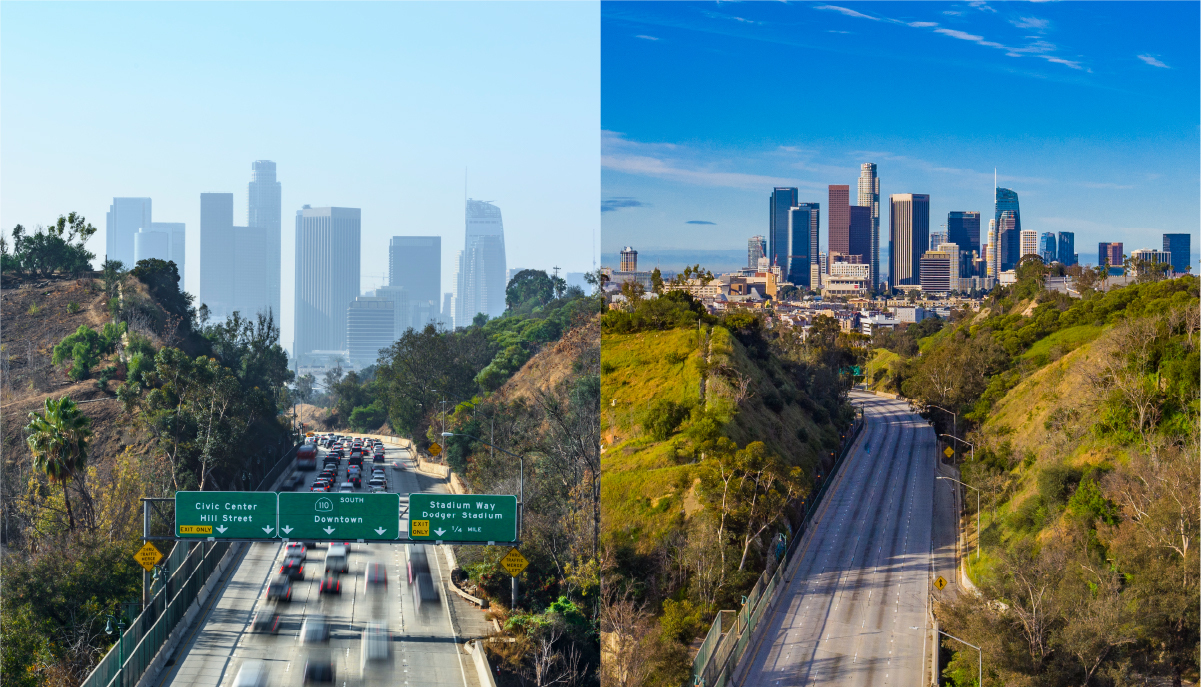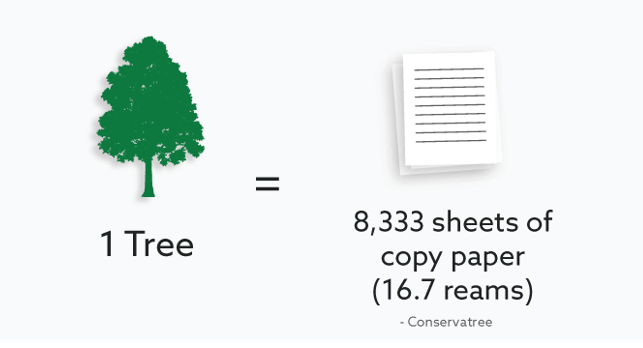4 Green ECM Trends for 2022

Look for our Green Tech label.
Did you know Enterprise Content Management products and services are behind the fastest-growing sustainability trend in business today?. According to a Deloitte survey, the shift to ECM-enabled remote work tops the list. In 2021, four in 10 companies encouraged hybrid work in part to reduce daily travel, double the number from the prior year, the survey found.[1] The second fastest trend was “educating the board and senior management on climate issues,” up by a third.
Overall, awareness about the many sustainability benefits of Enterprise Content Management products and services continues to grow. In addition to remote work, ECM enables eco-friendly practices such as digitization and automated business processes. Familiarize yourself with these Green ECM trends and how PaperVision® helps:
1. Smog-cutting benefits of
ECM-enabled remote work to stay in focus.

Photographs of the city of Los Angeles show the difference in traffic and air quality before (left, January 2018) and after (right, May 2020) COVID 19 work-from-home and stay-at-home orders went into effect.
The images were stunning. Seemingly overnight, the skies over major cities cleared of air pollution as workers stayed home at the start of the COVID-19 pandemic in early 2020. At one point in Los Angeles, vehicle traffic dropped by 80% and a measure of a particularly harmful air pollutant was down by 40%, UCLA researchers say [2]. While temporary, the absence of smoggy skylines left a lasting impression on employers and employees, contributing to a growing interest in ECM-enabled remote work.
Currently, researchers say they are working to better understand and quantify the environmental impacts of an expansion of remote and hybrid (part-time remote) work. They note that work from home brings its own environmental impacts. Meanwhile, some question how many organizations will make the shift permanent. “I think there’s a real risk that companies miss the boat on what could be a really important moment to bend the carbon curve over the long term,” Watershed co-founder Taylor Francis said[3] (Watershed helps companies monitor their carbon output).
How the PaperVision® product suite helps lessen vehicle emissions by enabling remote work:
- Scanning and capture: Convert paper-based documents into electronic files that can be shared by employees from anywhere.
- Cloud-based storage: Provide secure access to information from anywhere on virtually any device.
- Workflow automation: Automate billing, mailroom and other business processes.
However, surveys of employers and employees show hybrid work is likely here to stay. More than eight in 10 employers (83%) say the move to remote work was successful for their company, up from 73% in June 2020, according to a PwC report[4]. Among workers with jobs able to be performed remotely, 55% support working remotely at least three days per week, according to the same report.
Better air quality help for large cities would come if, as predicted, large numbers of employers and employees set up shop in small cities and rural areas. An estimated 14 million to 23 million Americans plan to move as a result of remote work, according to a 2020 survey by Upwork[5]. Of those, 20% now live in big cities, the company said.
Reduced pollution due to less vehicle traffic in big cities is one of the main environmental benefits of remote work, according to employment site FlexJobs. “When fewer people commute to work, there are fewer cars on the road. This, in turn, leads to less air pollution. Less air pollution benefits the environment by: decreasing acid rain, lowering the risk of algae blooms, producing less haze, decreasing ozone depletion and fighting climate change,” according to the report’. Other environmental benefits of remote work cited in the report: 1) lower greenhouse gas emissions, 2) less use of fossil fuels and 3) lower carbon footprint[6].
2. Public policy and funding support for digital transformation is strong.

Federal, state and local governments continue to show support and allocate public money for the digital transformation. The federal infrastructure spending bill signed into law in 2021 allocates $42 billion for extending broadband to rural and underserved areas. The benefits of broadband and related digital applications such as ECM are many. An improved environment is one of them.
The American Consumer Institute Center for Citizen Research estimates that widespread adoption and use of broadband-based applications could lead to an “incremental reduction of more than 1 billion tons of greenhouse gas emissions over ten years,” according to North Carolina State University’s Business Sustainability Collaborative.[7] The Sustainability Collaborative lists ECM-enabled remote work as an important offshoot of broadband improvements. “Telecommuting is one of the easiest ways to reduce the ecological cost of doing business. As home broadband speeds improve, many employees will be able to regularly skip the commute and be equally productive at home or a nearby coffee shop or co-working space. This allows companies to downsize their offices, reducing energy use and emissions associated with construction,” the group states in a 2015 report.
“All over the world, the costs of pollution—and the benefits of environmental sustainability—are increasingly recognized. China, some of the Gulf States, and India are investing in green energy on a scale that would have been considered improbable even a decade ago. Europe, including the United Kingdom, is united on addressing climate change. The United States is transitioning away from coal and is innovating in a wide array of green technologies, such as batteries, carbon-capture methods, and electric vehicles.” - McKinsey (2021)
3. Less paper (not paperless)

Given the popularity of paper, paperless offices aren’t in the offing but the environmental benefits of using less paper are as significant as ever. Copier and document paper remain in heavy use. And while the paper industry’s recycling and clean manufacturing efforts have lessened paper’s environmental impacts, paper still causes problems that ECM can lessen.
How the PaperVision® suite of products saves paper:
- Digitization (PaperVision Capture, PaperFlow, PaperVision Direct): Convert paper-based documents into easy-to-use electronic files.
- Electronic information management: ECM systems handle accounts payable, personnel and other business functions digitally.
- eForms and eSignatures: Collect information digitally from the outset.
Today, about a third of paper used in the US still is not recycled. (The paper recycling rate was 65.7% in 2020, up from 33.5% in 1990)[8]. One 500-sheet ream of paper uses about 6% of a typical 40-foot tree, according to the advocacy group Conservatree.[9]
Conservatree credits the paper industry for its development of “environmentally sound papers” but says “there is still much more to do.” Business and consumer shopping habits will play the major role going forward, the group says. “We cannot stress enough that purchasing agents are the key to making the shift from a 19th-century industrial development/environment-be-damned model of papermaking to a resource-conservative, minimal-impact 21st-century system,” the group says[10].
The benefits of using less paper go beyond tree and forest preservation. According to the Environmental Protection Agency, paper recycling and the use of less paper: [11]
- Reduces greenhouse gas emissions that can contribute to climate change by avoiding methane emissions and reducing energy required for a number of paper products.
- Extends the fiber supply and contributes to carbon sequestration.
- Saves considerable landfill space.
- Reduces energy and water consumption.
- Decreases the need for disposal (i.e., landfill or incineration which decreases the amount of CO2 produced).
4. More employers to include cost-saving ECM in their environmental plans
As more organizations integrate environmental sustainability principles into their businesses, ECM is one of the options drawing interest, according to executive surveys. ECM offers an opportunity to save money while aiding the environment as shown in the Seafood Producers case study, “What If You Could Go Green and Save Green?”
How PaperVision® enhances a company’s environmental sustainability plan:
- PaperVision®.com, ImageSilo® and other cloud-based tools offer a wide range of environmental benefits to include less use of paper and lower greenhouse gas emissions.
More than 80% of executives agree or strongly agree that businesses should make even greater efforts to protect the environment, according to a 2021 Deloitte survey.[12] Digitization and other workplace technologies are part of the mix, according to researcher McKinsey. “There’s no going back. The great acceleration in the use of technology, digitization, and new forms of working is going to be sustained. Many executives reported that they moved 20 to 25 times faster than they thought possible on things like building supply-chain redundancies, improving data security, and increasing the use of advanced technologies in operations,” McKinsey says[13].

Overall, Digitech Systems technologies, including digitization, ECM, cloud and the guarantee of Any Document, Anywhere, Anytime® faced its biggest test from the COVID 19 pandemic and, by all accounts, passed with flying colors. As for environmental benefits in particular, the shift to work-from-home showcased the ability to help reduce urban air pollution in a way never seen before. Other environmental benefits such as less use of paper and lower greenhouse gas emissions also will keep ECM in focus as more organizations focus on sustainability.
Check out the ways Digitech Systems technology aids sustainability by visiting our online Go Green with ECM section. Or contact us today for more information.
Deloitte (2021). “2021 Climate Check: Business Views on Environmental Sustainability.” Retrieved from: Business’ views on environmental sustainability (deloitte.com) ↩︎
CNN (April 2020). “Los Angeles air ‘cleanest in world’ since Covid-19.” Retrieved from: Los Angeles has less air pollution since COVID-19 lockdown keeps people off roads (9news.com.au) ↩︎
The Guardian (2021). “Is remote working better for the environment. Not necessarily.” Retrieved from: Is remote working better for the environment? Not necessarily | Environment | The Guardian ↩︎
PwC (2021). “It’s time to reimagine where and how work will get done.” Retrieved from: US Remote Work Survey: PwC ↩︎
Upwork (2020). “Economist Report: Remote Workers on the Move.” Retrieved from: Economist Report: Remote Workers on the Move | Upwork ↩︎
FlexJobs (2020). “The Environmental Impacts of Remote Work: Stats and Benefits.” Retrieved from: The Environmental Impacts of Remote Work: Stats and Benefits | FlexJobs ↩︎
North Carolina State University Business Sustainability Collaborative (2015). “How will fiber broadband impact sustainability.” Retrieved from: How will fiber broadband impact sustainability? | Business Sustainability Collaborative | NC State University (ncsu.edu) ↩︎
American Forest & Paper Association (2020). “Recycling During the Pandemic: 2020 Paper and Cardboard Recycling Rates Are In!” Retrieved from: Recycling During the Pandemic: 2020 Paper and Cardboard Recycling Rates Are In! (afandpa.org) ↩︎
Conservatree. (Undated). “Trees into Paper.” Retrieved from: http://conservatree.org/learn/EnviroIssues/TreeStats.shtml ↩︎
Conservatree. (Undated). “Your role as a consumer.” Retrieved from: http://www.conservatree.org/learn/Essential Issues/EIBuyers.shtml ↩︎
Environmental Protection Agency (undated). “Benefits of Paper Recycling.” Retrieved from: Basic Information Details | Paper Recycling | US EPA ↩︎
Deloitte (2021). “2021 Climate Check: Business’ Views on Environmental Sustainability”. Retrieved from: Business’ views on environmental sustainability (deloitte.com) ↩︎
McKinsey (2021). “The Next Normal. Business Trends for 2021.” Retrieved from: The Next Normal: Business Trends for 2021 | McKinsey ↩︎

Contact Info
+1 866.374.3569
Email Support
Email Sales
Daily: 8:00 am - 6:00 pm CST/CDT
Saturday & Sunday: Closed